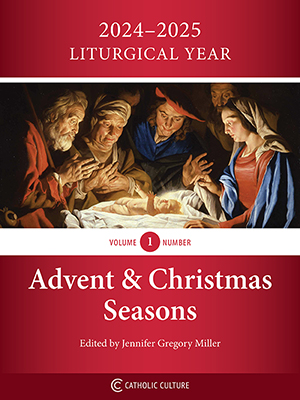Our Lady’s Thirty Days for Our Summer Malaise
By Jennifer Gregory Miller ( bio - articles - email ) | Aug 27, 2021
We are in the middle of “Our Lady’s Thirty Days” which began on the Solemnity of the Assumption of the Blessed Virgin Mary on August 15th. Now this isn’t an official liturgical feast or season found on the Liturgical Calendar or in liturgical books; the title comes from older traditions based on observations of patterns and living a Catholic culture, which combined the Liturgical Calendar with daily living.
In a previous post from 2014, Singing Our Lady’s Praises, I mentioned that in the current Liturgical Calendar there are 19 feasts of Mary (on the General Calendar and USA calendar), averaging about 1.5 feasts per month. During the timespan from August 15 through September 15 there are five Marian feasts (and if we include 40 days from August 5, there are six!). No other time during the year has so many Marian feast-days so close together:
- August 15, Solemnity of the Assumption of the Blessed Virgin Mary
- August 22, Queenship of Mary
- September 8, Nativity of Mary
- September 12, Most Holy Name of Mary
- September 15, Our Lady of Sorrows
I first learned about the Austrian/Bavarian tradition from Father Francis Weiser, an Austrian Jesuit (who was also a close friend to the Trapp family). He wrote about Our Lady’s Thirty Days and The Feast of the Assumptions Customs and Traditions in his The Holyday Book and Handbook of Christian Feasts and Customs. He uses a German/Austrian word, Frauendreissiger for these thirty days, and describes how images of Our Lady are clothed in a dress of grains for the feast of the Assumption, also in shrines dedicated to the Assumption. Maria im Gerteidekleid, Our Lady of the Grains, and devotion around Our Lady and the harvest, particularly of herbs and flowers continues through the month, with various ways of celebrating, including pilgrimages, prayer, and gatherings that incorporate decorations, crafts and foods of the harvest, particularly the “first fruits.” (Note: I’m not fluent in German, and I’m curious if these words are spelled correctly and what is the true translation. If any reader could help me, I’d appreciate it!)
The traditions begin with the Feast of the Assumption. There is a blessing of First Fruits: flowers and herbs and fruits, attached to this feast, one of the first harvest feasts. Some of the blessed herbs were dried and used throughout the year, continuing that special connection with Our Lady. The fragrant herbs and flowers tie in with the tradition that Mary’s incorrupt, sinless body left a trail of heavenly fragrance as it was assumed, and the empty tomb was filled with herbs and flowers. Florence Berger describes this “flowery” connection with Our Lady:
This day, as you know, is the principal and oldest feast of the Virgin. It is the first harvest feast of the year and correctly so, for Mary was a first fruit to be gathered into the Father’s barn. Whatever good men have done, whatever harvest God has reaped, is due in some measure to Mary: for through Mary we have “partaken of the fruit of life”: through Mary “true life flowed out to all.” So when the harvest was ripe Mary became first in time and eternity.The Church makes all things clear and just, as the pulse of living rounds the seasons. Assumption Day opens the harvest season and first fruits are sanctified. What are the first harvests of our farms and gardens? There are the grains, small fruits and vegetables, it is true; but on “the day of the great Lady” we little ladies harvested something especially feminine. We went to our gardens, picked our herbs and flowers, brought them to the Church and asked for them a special blessing (“Assumption Day,” Orate Fratres, Vol. XXIV, August 1950, No. 9, p. 412).
One day often does not feel enough for celebration. The Church illustrates that by providing octaves and seasons for celebration. We feel a need for more time. Even in my own family we joke about celebrating a “birthday octave,” and often a “birthday month” since we can’t get all our celebration into one day. And here in this medieval tradition of honoring Mary for 30 days we can see the patterns answering this human desire, and how the Church also recognizes and fills this need.
The Liturgical Year is not a static calendar that came about all at once, but slowly developed, expanded, and has been refined over the centuries. Saints’ days, octaves, vigils, rankings, etc., were added, subtracted over the years.
An octave is the celebration, prolonged for eight successive days, of the great feasts. The celebration of an octave is one area of the Liturgical Calendar that has really been refined. By the time of Pope St. Pius X, there were about 18 octaves through the year. Because there were so many, there needed to be a way to show the ranking of higher feasts. The octaves were then broken down into different types of categories: privileged, common and simple. Later other popes removed some octaves, and by 1955, only Christmas, Easter and Pentecost octaves remained. In the 1969 calendar reform the octave of Pentecost was also not included (this octave I hope is restored), leaving our current calendar with only Christmas and Easter octaves. But some of the traces of the earlier octaves remain embedded in our calendar.
For example, the Assumption was a common octave, which meant that not every day celebrated the octave if there was a similar or higher ranking feast that fell within the eight days. The liturgical pattern of octaves begins with a high feast and ends with another feast that pointed back to the original feast. So the Assumption “octave” concludes on August 22, which was formerly the Immaculate Heart of Mary but is now the Queenship of Mary (and this year was not celebrated since it fell on Sunday). Both are high feasts of Mary, pointing back to the Assumption.
The Thirty Days have “bookends”: an “octave” at the beginning and an “octave” at the end. September 8, the Nativity of Mary, is the next octave (which was a common octave), ending with the feast of Our Lady of Sorrows on September 15. During this “octave” is the Most Holy Name of Mary, which would traditionally be eight days after the birth of Mary, so the Church keeps a feast in honor of Mary’s most holy name.
The bookends account for 16 days, and there are 16 days in between. There are no Marian liturgical connections for the middle 16 days, but it is time to further our focus on Our Lady. There is room for growing in love and knowledge for our Blessed Mother during this late summer season. It can be a time for expansion on crafts or recipes as reflections of Mary during this harvest time. We can continue our incorporation of first fruits, flowers and herbs. A walk in the meadow, a saunter in the garden, a trip to the farmer’s market or a run to the grocery store can provide various fragrant flowers and herbs. There is time to identify the different varieties, find out the herbs and flowers named for Our Lady, see which ones can be made into sachets or potpourri or soap or candles, incorporate them into cooking or baking, and which ones are medicinal. Maybe this could be the time to start researching and using some essential oils—perhaps the ones that are reminders of Our Lady, such as rosemary, lavender and mint.
There are certain times of the year that we dedicate to Our Lady. There is the month of May (we are considering her role and joy in the Resurrection during the new life of spring) and October, the month of the Rosary. Advent also has a Marian focus. As I mentioned in my previous posts of August, the end of summer seems to mark a time we need a boost to help restart spiritually. I’m realizing that over the years our family has unconsciously followed this “Thirty Days.” We fall into bad habits over the summer. It is the summer Marian feasts that help us, and we return back to our daily rosary routine as a family, usually starting around the Assumption.
I find this late summer Germanic tradition fits perfectly into this cluster of five feasts of Mary. Just recognizing the patterns and feast days can help bring back structure to our summer malaise.
For Further Reading:
- Feastday Highlights: The Assumption and Our Lady’s Thirty Days
- The Solemnity of the Assumption: Adding in Marian Wonder
- Singing Our Lady’s Praises
- The Catholic Tradition of Harvest Feasts of Thanksgiving
- Understanding our Family’s High Feasts
- Reading the Fine Print for our Liturgical Calendar (Part 1)
- Our Lady’s Thirty Days by Father Francis Weiser, SJ
- The Feast of the Assumption Customs and Traditions by Father Francis Weiser, SJ
- Blessing of Fruits and Herbs on the Assumption of the Blessed Virgin Mary
All comments are moderated. To lighten our editing burden, only current donors are allowed to Sound Off. If you are a current donor, log in to see the comment form; otherwise please support our work, and Sound Off!








